Going Green in China: Firms’ Responses to Stricter Environmental Regulations
Evidence from China shows that firms respond to stricter enforcement of the emission reduction target by reducing their pollution. This effect is stronger for firms in industries with higher pollution intensity. Stricter environmental regulations also lead to sharp declines in firms’ profits, capital, and labor. A sequence of tests of the underlying mechanisms reveals that firms rely more on recycling and abatement investment than on innovations to meet environmental requirements.

Figure 1: Chemical Oxygen Demand (COD) Emission in Chinese Manufacturing
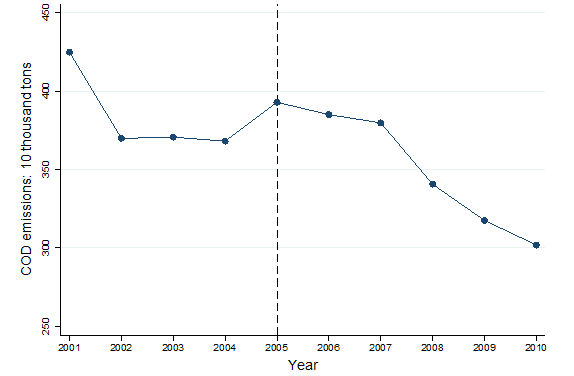
Emission Control in China
Though it was established in the 1980s, the Chinese government had not seriously enforced emissions target control until the 11th Five-Year Plan from 2006 to 2010. To reverse the failure in achieving the emissions control targets during the 10th Five-Year Plan, the government substantively strengthened the emissions target control scheme in the 11th Five-Year Plan period. After translating the national goal at the provincial level, the national Ministry of Environmental Protection accordingly signed the goal statements on emissions reductions with each provincial government. The performance of government officers in fulfilling their duties relating to the emissions mandates, according to Measures on Accomplishment Evaluation of Critical Pollutants Emissions Control Target, were evaluated and incorporated into their competency assessment, with potential impacts on their accountability and promotion. Moreover, other complementary regulations, such as Statistical Measures on Critical Pollutants Emissions Control Target and Interim Verifying Measures on Critical Pollutants Emissions Control Target, were enacted in 2006. We document three findings pertaining to COD emissions from manufacturing in China from 2001 to 2010, covering the 11th Five-Year Plan period.First, as Figure 2 shows, in response to different level of environmental regulation, firms located in tightly regulated provinces (those assigned with above-median COD reduction targets) reduced more pollutants, in comparison to their counterparts in loosely regulated provinces (those with below-median COD reduction).
Figure 2: COD Emissions in Manufacturing in Tightly and Loosely Regulated Provinces
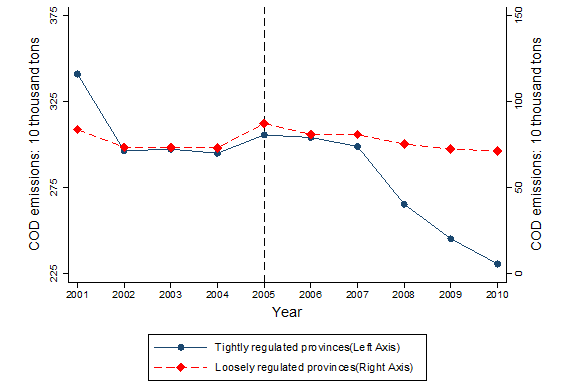
Second, the effect of environmental regulation stringency on firms’ COD emissions varied across industries with different levels of polluting intensity. Regardless of whether they are located in tightly or loosely regulated provinces, firms in heavily polluting industries all experienced declines in COD emissions, whereas COD emissions of firms in lightly polluting industries located in tightly regulated provinces even increased during the same time period (Figure 3). This might suggest that industrial pollution intensity positively reinforces the effect of environmental regulation on firms’ pollution reduction.
Figure 3: COD Emissions in Manufacturing with Different Pollution Intensities in Tightly and Loosely Regulated Provinces
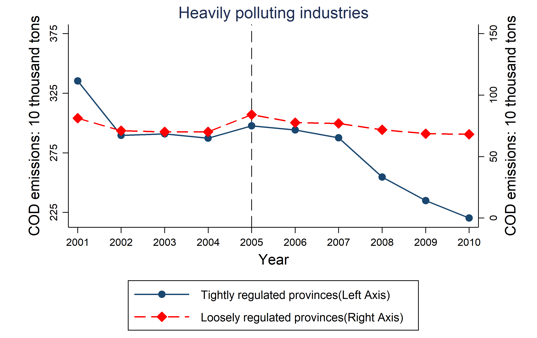
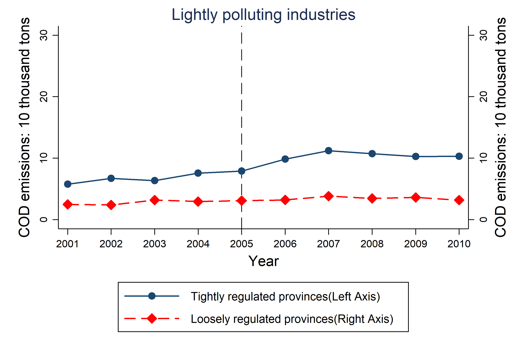
Third, following Levinson (2009), we decompose changes in total manufacturing COD emissions as changes into a “composition effect” (adjustment of market share of each industry) and a “technique effect” (lowered pollution intensity brought by technological progress). Figure 4 implies that both effects exist, although the “technique effect” is the predominant driving factor.
Figure 4: Decompostion of the Three Main Effects Causing COD Emissions in Chinese Manufacturing
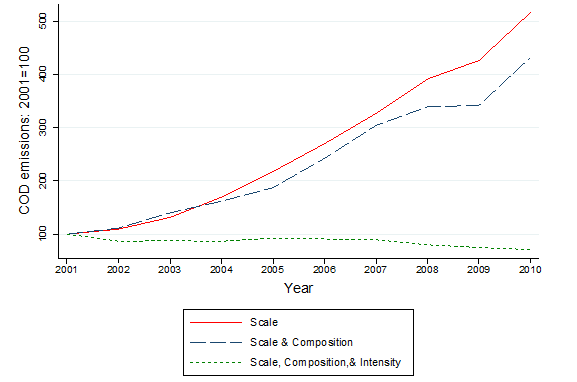
Firms’ Adjustments to Stricter Environmental Regulation
The above three findings provide intuitive evidence that strengthening enforcement of emissions reduction control and greater controls on industrial pollution intensity have positive effects on firms’ pollution control. After rigorous analyses, our main findings are as follows.Pollution has been reduced due to better enforcement of emission target control, and “technique effect” is a predominant cause of emission reduction. We find that more stringent environmental regulations faced by firms are positively associated with greater probability of reducing COD emissions after 2006. A within-firm decomposition further shows that within-firm “scale effect”—that is, the drop in firms’ total output—explains approximately 30 percent of the emission reduction, whereas within-firm “technique effect,” explains about 70 percent of the emission reduction. The latter effect includes but is not limited to the adoption of pollution abatement facilities, introduction of cleaner production processes, and recycling use of energy inputs.
Industrial heterogeneous effects exist. Considering the large variation in COD emission across industries, we find that, firms that belong to heavily polluting industries located in cities with more stringent environmental regulations cut down on pollutants much more, compared with their intra-city counterparts in less-polluting industries.
Four main mechanisms linking stricter regulation to reduced emission are: stricter environmental penalties, decreasing industrial wastewater discharge, recycling use of industrial water, and adoption of pollution control devices. With the stricter target control system in place, firms face a higher probability of receiving administrative penalties and are more likely to discharge less effluent, to consume less industrial water by recycling water, and to adopt devices that control pollution as well as expand their current pollution treatment abilities.
The emission target control during the 11th Five-Year Plan period failed to stimulate firms to become innovators. We find no evidence of an increase in green patents and water-related green patent applications, leading us to believe that firms are, nevertheless, reluctant to increase environmental innovation. The reason may be that other lower-cost countermeasures, such as pollution abatement facilities, are sufficient to meet the target.Expansion of cleaner industries leads to a cleaner industrial structure. As firms in heavily polluting industries are more responsive to environmental regulations, their sharply declining output and the pollution intensities of their production provide more evidence of the “composition effect.”
Firms’ economic performance—indicated by their profits, capital, labor, and market share—have deteriorated. Also, the relocation of firms after 2006 to cities with stringent environmental regulation plunged sharply compared with those in loosely regulated cities, which signifies, to a certain extent, an “internal” variant of the pollution havens hypothesis.
Conclusion and Policy Implications
These patterns show that, as environmental regulations become tighter, firms’ emissions fall. To achieve concrete emissions reduction targets, firms are consciously trading off between production arrangements and COD emissions. Overall, manufacturing firms in China are becoming green. Also, the industrial infrastructure in China is becoming cleaner due to the expansion of cleaner industries, while polluting industries are shrinking. As firms in heavily polluting industries are more responsive to environmental regulations, their sharply declining output and the pollution intensities of their production provide more evidence of the “composition effect.” In addition, although clear reduction targets set during the 11th Five-Year Plan were effective, they still failed to stimulate firms to adopt effective technology to eliminate more pollutants from the production process, perhaps because other lower-cost countermeasures, such as adoption of pollution abatement facilities, were sufficient to meet the target. Regulators still face the fundamental challenges of identifying an appropriate regulatory path that will stimulate firms to shift from the adoption of end-of-pipe treatment technology to innovations.
Note 1: COD is an indicative measure of the amount of oxygen that can be consumed by reactions in a volume of water to reflect water quality.
This research belongs to the NBER working paper series (No. 26540), which is accessible through https://www.nber.org/papers/w26540.
(Haichao Fan is Professor in School of Economics at Fudan University; Joshua Graff Zivin, University of California, San Diego; Zonglai Kou is Professor of Economics and Deputy Dean of the School of Economics at Fudan University; Xueyue Liu is a Postdoc Fellow at Fudan University; Huanhuan Wang is an Associate Professor at East China Normal University.)
References
Becker, Randy, and Vernon Henderson (2000). “Effects of Air Quality Regulations on Polluting Industries,” Journal of Political Economy 108(2): 379–421.
Berman, Eli, and Linda T. M. Bui (2001). “Environmental Regulation and Productivity: Evidence from Oil Refineries,” Review of Economics and Statistics 83(3): 498–510.
Cai, Xiqian, Yi Lu, Mingqin Wu, and Linhui Yu (2016). “Does Environmental Regulation Drive Away Inbound Foreign Direct Investment? Evidence from a Quasi-natural Experiment in China,” Journal of Development Economics 123: 73–85.
Chay, Kenneth Y., and Michael Greenstone (2005). “Does Air Quality Matter? Evidence from the Housing Market,” Journal of Political Economy 113(2): 376–424.
Chen, Zhao, Matthew E. Kahn, Yu Liu, and Zhi Wang (2018). “The Consequences of Spatially Differentiated Water Pollution Regulation in China,” Journal of Environmental Economics and Management 88: 468–485.
Greenstone, Michael (2002). “The Impacts of Environmental Regulations on Industrial Activity: Evidence from the 1970 and 1977 Clean Air Act Amendments and the Census of Manufactures,” Journal of Political Economy 110(6): 1175–1219.
Greenstone, Michael, and Rema Hanna (2014). “Environmental Regulations, Air and Water Pollution, and Infant Mortality in India,” American Economic Review 104(10): 3038–3072.
Greenstone, Michael, John A. List, and Chad Syverson (2012). “The Effects of Environmental Regulation on the Competitiveness of US Manufacturing,” NBER Working Paper (No.18392).
Gutiérrez, Emilio, and Kensuke Teshima (2018). “Abatement Expenditures, Technology Choice, and Environmental Performance: Evidence from Firm Responses to Import Competition in Mexico,” Journal of Development Economics 133: 264–274.
Henderson, J. Vernon (1996). “Effects of Air Quality Regulation,” The American Economic Review 86(4): 789–789.
Keller, Wolfgang, and Arik Levinson (2002). “Pollution Abatement Costs and Foreign Direct Investment Inflows to U.S. States,” Review of Economics and Statistics 84(4): 691–703.
Levinson, Arik (2009). “Technology, International Trade, and Pollution from U.S. Manufacturing,” American Economic Review 99(5): 2177–2192.
Nelson, Randy A., Tom Tietenberg, and Michael R Donihue (1993). “Differential Environmental Regulation: Effects on Electric Utility Capital Turnover and Emissions,” The Review of Economics and Statistics, 75(2): 368–373.
Shi, Xinzheng, and Zhufeng Xu (2018). “Environmental Regulation and Firm Exports: Evidence from the Eleventh Five-Year Plan in China,” Journal of Environmental Economics and Management 89: 187–200.
Walker, W. Reed (2013). “The Transitional Costs of Sectoral Reallocation: Evidence from the Clean Air Act and the Workforce,” The Quarterly Journal of Economics 128(4): 1787–1835.

Latest
Most Popular
- VoxChina Covid-19 Forum (Second Edition): China’s Post-Lockdown Economic Recovery VoxChina, Apr 18, 2020
- China’s Great Housing Boom Kaiji Chen, Yi Wen, Oct 11, 2017
- China’s Joint Venture Policy and the International Transfer of Technology Kun Jiang, Wolfgang Keller, Larry D. Qiu, William Ridley, Feb 06, 2019
- The Dark Side of the Chinese Fiscal Stimulus: Evidence from Local Government Debt Yi Huang, Marco Pagano, Ugo Panizza, Jun 28, 2017
- Wealth Redistribution in the Chinese Stock Market: the Role of Bubbles and Crashes Li An, Jiangze Bian, Dong Lou, Donghui Shi, Jul 01, 2020
- What Is Special about China’s Housing Boom? Edward L. Glaeser, Wei Huang, Yueran Ma, Andrei Shleifer, Jun 20, 2017
- Evaluating Risk across Chinese Housing Markets Yongheng Deng, Joseph Gyourko, Jing Wu, Aug 02, 2017
- Privatization and Productivity in China Yuyu Chen, Mitsuru Igami, Masayuki Sawada, Mo Xiao, Jan 31, 2018
- How did China Move Up the Global Value Chains? Hiau Looi Kee, Heiwai Tang, Aug 30, 2017
- China’s Shadow Banking Sector: Wealth Management Products and Issuing Banks Viral V. Acharya, Jun Qian, Zhishu Yang, Aug 09, 2017




 Facebook
Facebook  Twitter
Twitter  Instagram
Instagram WeChat
WeChat  Email
Email 



